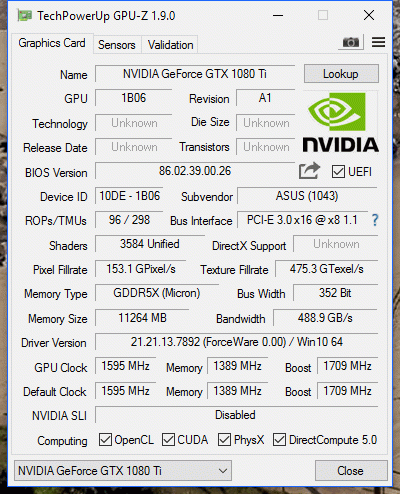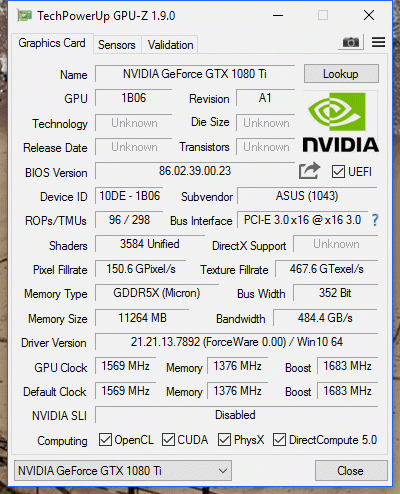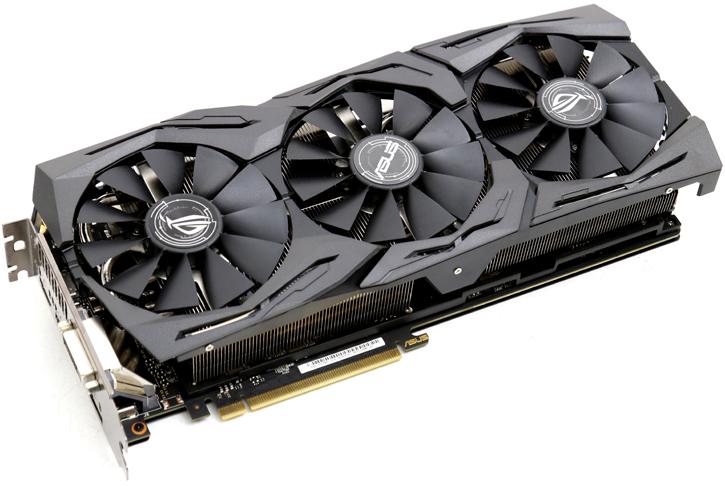Introduction
ASUS ROG Strix GeForce GTX 1080 Ti OC 11GB
Testing & Benchmarking The OC Edition
We review the final version of the ASUS ROG Strix GeForce GTX 1080 Ti 11GB, and not the engineering samples you have seen reviewed two weeks ago. This GeForce GTX 1080 Ti comes all customized with a brand new cooler (not Direct CU) and RGB Headers on-board of the card to attach RGB LEDs.
In this article we'll look at the fastest graphics card your money can get you, the Nvidia GeForce GTX 1080 Ti based on Pascal architecture. Armed with 11GB of GDDR5X graphics memory and an all new GP102-350 GPU, we are certainly we're gonna break some records today. It has been eight months since Nvidia released the first GP102 based product, the Titan X. To date, a massively impressive graphics card that will resemble what we review today and very similar on a lot of levels. Really, the 1080 Ti is the Titan X, just with one GB of that GDDR5X memory less and the one ROP partition tied to it. So let me break it down swift and fast, the new high-end GTX 1080 Ti features 3584 CUDA Cores, 224 Texture Units, a 352-bit memory controller and 11 GB of faster (11 Gbps) GDDR5X memory. The card has the same "GP102" GPU as the TITAN X Pascal, but the GTX 1080 Ti was slightly reconfigured. Most interesting is the 352-bit wide GDDR5X memory interface, this was not expected. This translates to 11 memory chips on the card which run at 11 GHz (GDDR5X-effective), the memory bandwidth is 484 GB/s. This invokes the change in ROP count to 88 (from 96 on the TITAN X Pascal), and the TMU count of 224.
The Pascal based unit is a bit of a beast alright, the GPU die size is 471 sq mm. If you look at the wider product stack, then a GeForce GTX 1080 has 2,560 shader processors, the GeForce GTX 1070 has 1,920 shader processors, the GeForce GTX 1060 has 1,280 of them. The Nvidia GeForce 1080 Ti has 3,584 shader processors active inside that GP102 GPU, I say active here deliberately as it still isn't even a fully enabled GPU. This means it is has 28 SMs active (28 streaming multi-processors x 128 shader cores (2x64). The cards will be equipped with fast GDDR5X memory as well for this 11 GB model. That memory is tied to a 352-bit wide bus locked in at 11 GHz (GDDR5X-effective). The combination of that memory type and clock frequency gives the 1080 Ti an effective memory bandwidth of 484 GB/s.
ASUS once again is back in the house to offer you the a very silent product with the usual looks to go with it of course. The beastly Pascal GPU empowered product however needs cooling to keep it at or under the 70 Degrees C marker. The STRIX branded model comes with a new design cooler which has MaxContact Technology and should offer twice the contact with GPU area for improved thermal transfer. Not just that, the contact surface area has increased by 40% compared to the older 1080 STRIX. This also means that ASUS now has said goodby (for now) from the Direct Touch heatpipe concept. The new cooling block has a mirror finish and now simply has a somewhat more regular baseplate with the heatpipes leading through them. Back to the roots with a traditional design one might call it even. ASUS still applies three fans for the cooler fin surface area, the new spinners have IP5X certification, making them more dust resistant. Under 55 degrees C the card will remain passive and the fans thus do not spin. So looking at it from every point of view, ASUS has been focussing on cooling and low noise levels. They have been working hard on the product to do things right, you will notice a lot of customization for this board. A completely automated production line will make incredibly clean looking PCBs. The card will have ten power phases just for the GPU and an additional two for the memory subsystem. Obviously ASUS as well is making use of high quality components like the best SAP capacitors, alloy chokes and mosfets (DrMOS), all housed under the name Super Alloy Power II. We test this STRIX with with default clocks straight out of the box these will be:
- Base clock: 1569 MHz
- Turbo clock: 1683 MHz
- Memory clock: 11010 Mhz (effective data-rate)
As you can see the review boards sent out are locked and loaded in the OC mode for GPU and Memory clocks. I have spotted some reviews from other media using the wrong BIOS/clocks. This OC setting normally you can only access and enable with ASUS GPU Tweak software (you'd need to run that software in the background as each time you restart this software modus needs to re-enable the clocks). After contacting the ASUS marketing team we received and upgraded the card with the retail BIOS:




